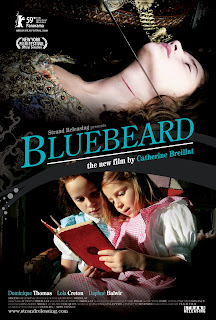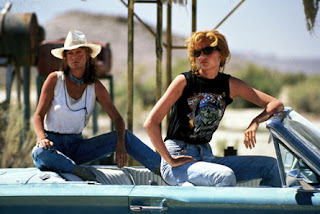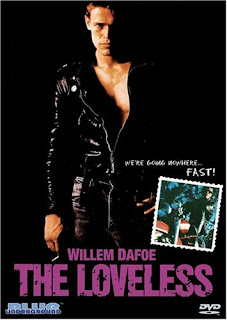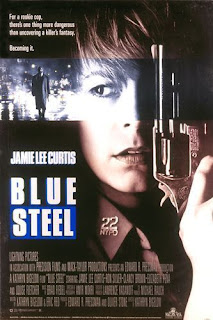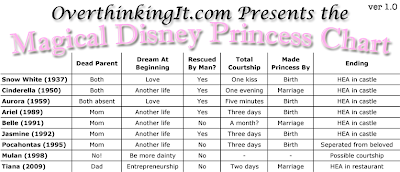Survey Third Wave communities and one descriptive phrase keeps coming up over and over again regarding Lady Gaga—badass. In such spaces, no higher compliment could ever be paid than that. When so many women feel that their voices are routinely stifled or that they’ve been conditioned to stay silent while men talk first and act first, young feminists understandably find something courageous and enviable about women, particularly women their own age, who force the world to accept them on their own terms. Furthermore, Lady Gaga’s music videos in particular have directly, though a bit clumsily at times, taken on questions of same-sex attraction between women and done so in terms that are far closer to the way it actually exists in reality. The pure fantasy and grotesque parody of lesbianism, itself a construct clearly adopted by men, is at least pushed to the background of her work rather than set forth as the truth.
The first three minutes are lost on me and left me confused, offended, and too pissed of to appreciate the next few minutes. Had the video started when the song started, I might (might) have been able to stomach the rest of the prison scenes. However, after the objectification, glamorizing of lesbian fetishism, and excessive girl-on-girl violence I was too pissed to rationalize sitting through the first dance routine, which could have just as well been the Pussycat Dolls (whom Gaga has written for in the past). Feminist Gaga fans can try to justify this as another example of how she subversively turns what we usually find hot into something that leaves a nasty taste in our mouths and therefore makes a statement, but if any other artist (particularly any male artist) incorporated this much objectification and violence against women we would be outraged. Is it any different just because it’s a woman, or because it’s specifically Gaga?
What do you think about the new breed of younger pop stars — and some have accused Gaga of this — who claim bisexuality or a kind of pansexuality in an effort to use queer culture for their own personal gains?
That’s been going on since the dawn of time. Elvis stole from African American music. Everybody’s constantly riffing — Madonna stole voguing from poor, disenfranchised black drag queens in Harlem. This isn’t a new concept. I think there’s more reverence with regard to Lady Gaga as she’s obviously educated herself in her trajectory with visual arts practices and the stuff that she’s doing isn’t light stuff. It’s difficult when they’re making millions of dollars and placating to the masses — it’s tricky to maintain that, but I think she tries. And even including someone like me is a part of that. The thing that was kind of interesting was that in between takes I was getting kind of annoyed because the camera guys were really kind of drooling and talking about “girl-on-girl action” and I said, “What about boy-on-girl action?” And she turned to me and said “Oh. Do you identify as male?” [Laughs] And I said, “Well, probably more than you do.” And she said “I’ll be sure to tell people that.” We just had this abstracted conversation about gender in the middle of this shoot, which I thought was really weird and pretty interesting: A) that she would take the time and B) that she would even ask me about that.
Ms. Magazine Blog “Is Lady Gaga a Feminist or Isn’t She?” by Noelle Williams:
Her art provides a running commentary on gender, sexuality and beauty. There are hints of David Bowie, Prince and Madonna in the way she plays with sexuality, but while Gaga acknowledges these similarities she wants it to be clear she is something entirely her own. With her deliberate juxtaposition of conventional platinum blonde beauty and fashionably ugly costumes, she toys with conventional rules of attractiveness. Half of her appeal throughout 2009 seemed to be the question of whether or not she was pretty, whether or not people felt comfortable liking her. “I am not sexy in the way Britney Spears is sexy,” Gaga is quoted in the bio, “I just don’t have the same ideas about sexuality that I want to portray. I have a very specific aesthetic–androgyny.”
Replete with references to films like Caged Heat, Kill Bill, Thelma and Louise, and heaped with nods to golden age sexploitation from Russ Meyer flics to Betty Page pin ups to busty comic book heroines like Wonder Woman (H/T Lisa Duggan and Sam Icklow for IDing some of these for me), Telephone is a high femme pastiche of mini-epic proportions.
The plot is straightforward: thrown into “prison for bitches,” Gaga is bailed out by co-star Beyoncé (in a telling reversal of the usual hierarchy between white and black), and the two then set of on a mission of vengeance against Beyoncé’s boorish beau, played by male model/singer/actor Tyrese. But this bare summary belies the profusion of signifiers strewn across the surfaces of this visual feast of a video. To attempt to account for them all (crowdsource project anyone?) would leave any critic floundering on the shoals of interpretation. So I’ll just focus on one, ahem, prime signifier: Lady Gaga’s penis.
The video is peppered with both real (e.g. Miracle Whip, Wonder Bread, Polaroid, Chanel, Diet Coke, Virgin, Plenty of Fish) and fake products (e.g. Poison TV, Double-Breasted Drive-Thru, CookNKill Recipes). This combination of real and fake allows the video to both enjoy the benefits of product placement, and parody the enterprise in the same swoop. Once again, we’re dealing, I think, with a carnivalesque aesthetic, or a type of conceptualist art that parodies by displaying too loudly or too blatantly that which is being mocked. The comfortably familiar form is being used to market poison, and at the same time its used to promote Polaroid. Gaga’s having her cake and eating it too.
In this entire video, as well as, “Bad Romance” and “Paparazzi,” Gaga reverses this gaze in a variety of ways. She refuses the male heterosexual narrative as the only way to see the world, and presents her views in a decidedly “feminine gaze” or at least a gaze that does not abide by male standards. Women’s bodies are not present in “Telephone” for male pleasure, they do not progress a male storyline, nor are women defeated for male purposes of sex or domestication. Women are not “othered.” In some ways, the bodies seen here are for female pleasure, sexual perhaps, or at least aiding in seeing women in positions of power, both as prisoners and prison guards. Women are in control, even in prison and outside of it. Gaga and Beyoncé’s emotions, ideas, and selves drive the story of the music video, not men’s. Women are central, not peripheral, they are the main autonomous actors in control of their destinies. Even as we see women in traditionally powerless situations, in prison, as diner wage workers, or as objectified bodies for male consumption, these positions are problemitized, and their meanings changed. When we see women in these places, we do not get the impression that they are mere tools of the patriarchy. They have agency, they have will, and they are not the “other.” We get a unique and visually appealing story from women’s perspectives, ideals, and world view that is so lacking in today’s media.
Gudbuy t’jane’s “Lady Gaga sets the record straight:
As a trans woman, she mostly caught my attention due to the transphobic and intersex-phobic rumours about her being either trans or intersex. While these rumours were typically a product of living in a transphobic and transmisogynist culture, Lady Gaga’s response was one of gender and genital essentialism, stating that her vagina was offended by the claims.
To me, the absurdity of that mismatch is part of the point: incredible frivolity combined with serious issues. People go to clubs and complain about reception while prisoners cannot get a proper phone connection and are strip-searched for no other reason than the guards’ prurient interests all the time. Outside of a Lady Gaga video, however, it usually isn’t the same people who have a dance party and are abused in prison (at least not simultaneously), nor do the dance parties (which occur at the same time as mass murder) usually happen at the crime scene.
By collapsing the distance between these events, “Telephone” points to the absurdity of a world in which people dance even though they are aware that other people are suffering, an awareness intensified by the very medium for which “Telephone” was created.
Thus begins the epic dance break—celebrating a new America. An America that steers away from gender constructs. An America where you don’t have to wear pants! Lady Gaga is the modern-day Wonder Woman—a DC Comics superheroine created in the early ’40s and regarded as the model of the feminist movement. Created by Dr. William Marston, Wonder Woman is an Amazon princess sent to earth to assist America in the war effort. Called upon by the goddess Aphrodite, Wonder Woman was “created as a distinctly feminist role model whose mission was to bring the Amazon ideals of love, peace, and sexual equality to ‘a world torn by the hatred of men.” However, Wonder Woman loses her powers if a man binds together her trademark bracelets, and she’s commonly depicted as being chained by male villains and having to break free of their power and control. We see these details referenced through Gaga’s chained-getup in the prison sequence, and in the Wonder Bread appearance.
Fox News reaction:
Gaga’s relationship with feminism is uneasy and uncertain, not unlike my own, and even as she has more recently copped to being “a little bit of a feminist” after a long period of rejecting the term, her work seems more inclined toward interrogating and challenging culture, sexism, and exploitation without necessarily overtly condemning it. This video is no exception, dabbling as it does in lesbian undertones combined with a monstrous revenge fantasy and mass murder literally draped in American flags, and concluding with the infamous Thelma & Louise hand-clasp which serves as a forceful barring-of-the-door against the meddling of trifiling men who’d seek to break our terrifying yet compelling heroines apart. The visuals are riddled with sex from beginning to end, but it’s complicated sex, a queer romp dressed up in straight drag. The lingering shot on Beyoncé’s cleavage is so unabashed as to be uncomfortable, which is insane considering the amount of women’s cleavage media serves up on a daily basis, but like the product placement, we are accustomed to it being more subtle. The overtness here renders our standard voyeurism into something downright embarrassing. The prison-yard makeout-sequence is likewise skewed and queerified, as it shows a lesbian hookup that would be of great appeal to straight men if only it involved two women with larger breasts and more traditionally-feminine presentations; instead we see Gaga paired with a decidedly butch partner, whilst surrounded by fellow inmates representing a diversity of genders, shapes, sizes, and ethnicities.
Kelsey: so she went to jail for murdering that guy and it was supposed to be a statement about celebrity and fame and now she is sort of doing the same thing but starting in “fame jail” where there are lots of hot lesbians
Kjerstin: so she’s sort of addressing the intersex rumor, but as one blogger at gudbuytjane pointed out, is it transmysoginistic to be like “see, no dick!”
Andi: That’s definitely what I thought. Maybe she wants to start it up again?
Kjerstin: it also happens so early in the video
Kelsey: she has been so intentionally vague about the intersex thing, I’m surprised she’d address it like this (or maybe I’m not)
Kjerstin: it’s extra shocking
Kelsey: but yeah, like gudbuytjane said, it’s like “Oh thank God she doesn’t have a dick now I can relax”
In an interview with Carson Daly on LA’s 97.1 AMP radio, Gaga remarked that the video’s concept revolves around a critical look at the inundation of media in our modern lives and the sort of brainwashing the mass marketing of everything from tampons to pop artists to fast food creates when it tells us what to think. This makes me want to ask you girls some study questions: Is Lady Gaga trapped in a prison of what pop music is expected to be? Is that why she is so determined to escape? Is her “punishment” for being an independent woman — represented in the extreme by killing her sadistic boyfriend — a metaphor for being stuck behind the bars of what the record labels demand of their cookie-cutter pop artists? But wait a second, there are hot lesbians in prison. Is being sent to a jail full of sexy women a reward for ditching some man she didn’t really want? Where is the intersection of queerness, prison culture and femininity? Is homosexuality a behavior, an all-encompassing identity, or a complicated blend of both? So many layers here, like peel-and-eat lingerie (did I just say that?)
Because if there’s one thing that we’ve seen a thousand times over the past few decades, it’s old-style sexism dressed up as new-style irony. Does the fact that Gaga seems to be winking knowingly at the camera as she dances in a bikini make the vision any less predictable, any less boring, any less reminiscent of sexist video after sexist video that you’ve seen in the past few years? Nope. It’s a disappointment from someone who seems to be popping with so many ideas. Gaga will do something great, I’m sure. But this isn’t it.
If you find/have written any interesting Gaga-analysis related to “Telephone,” leave your links in the comments!








